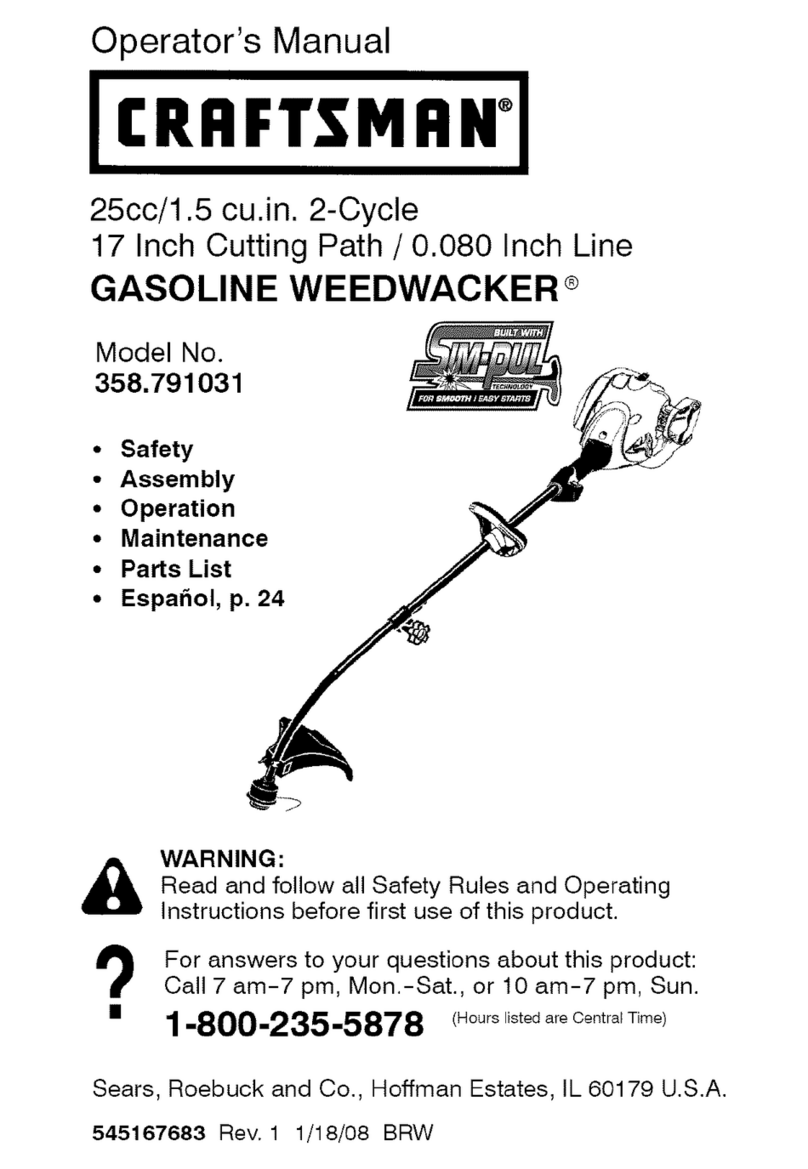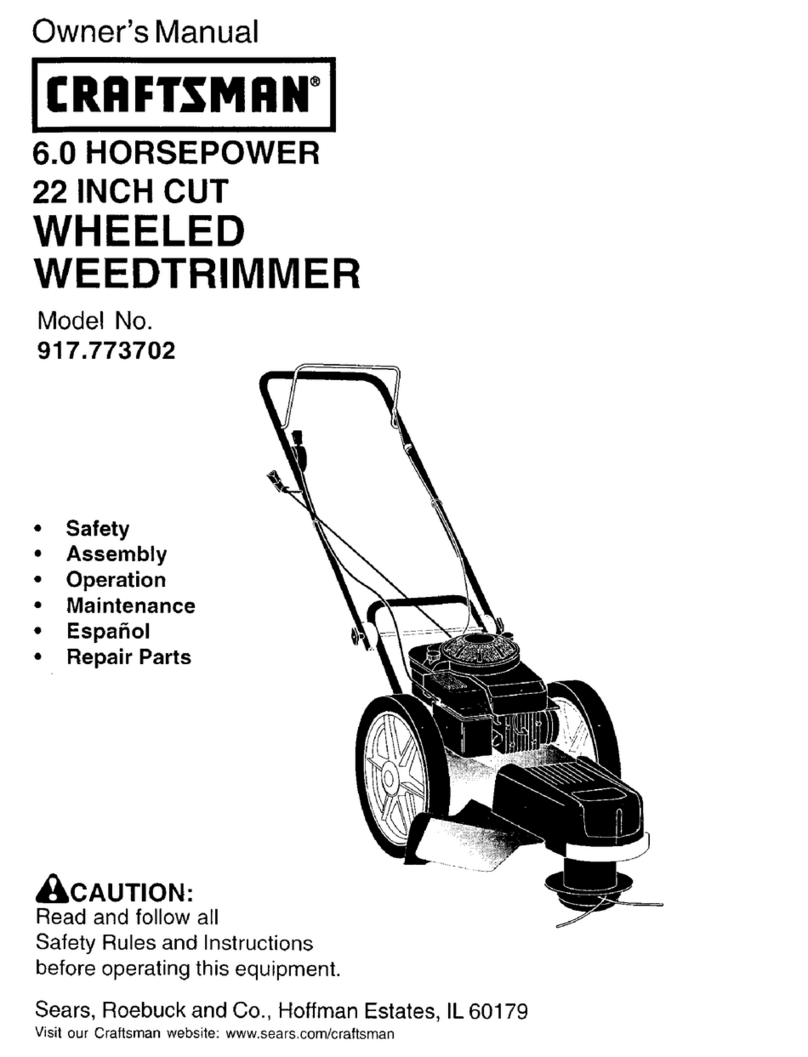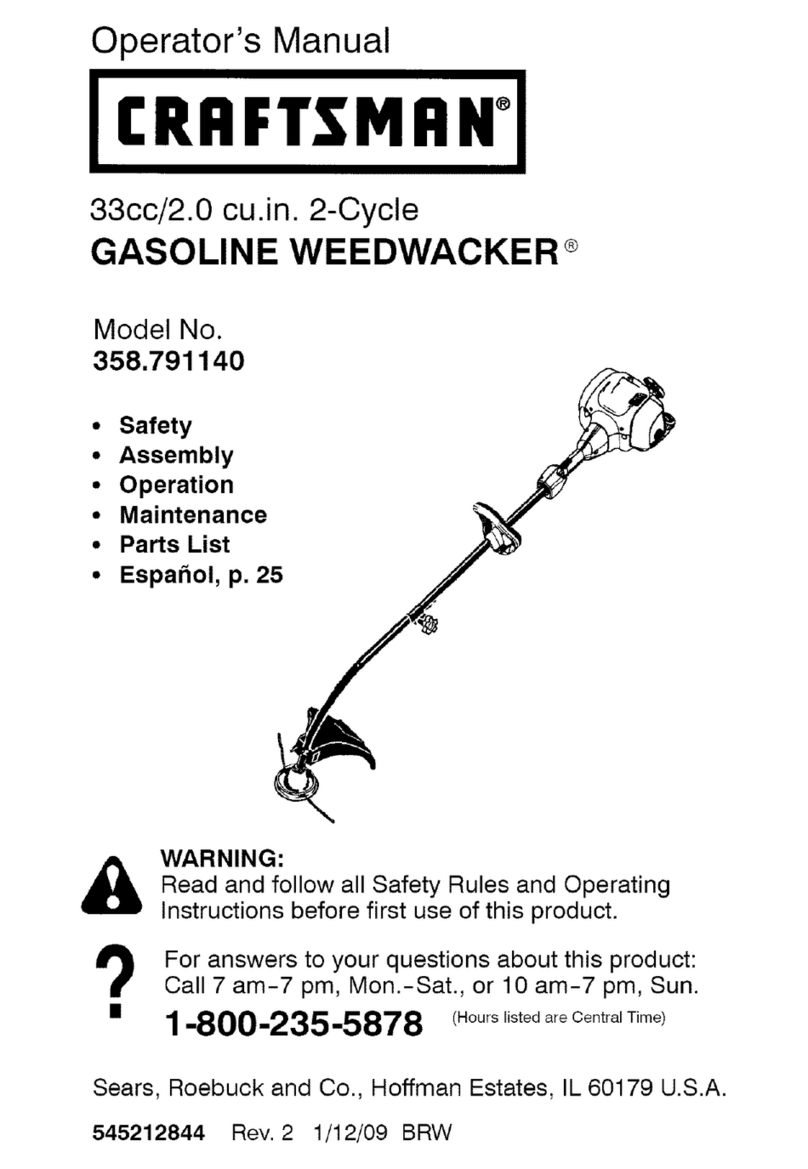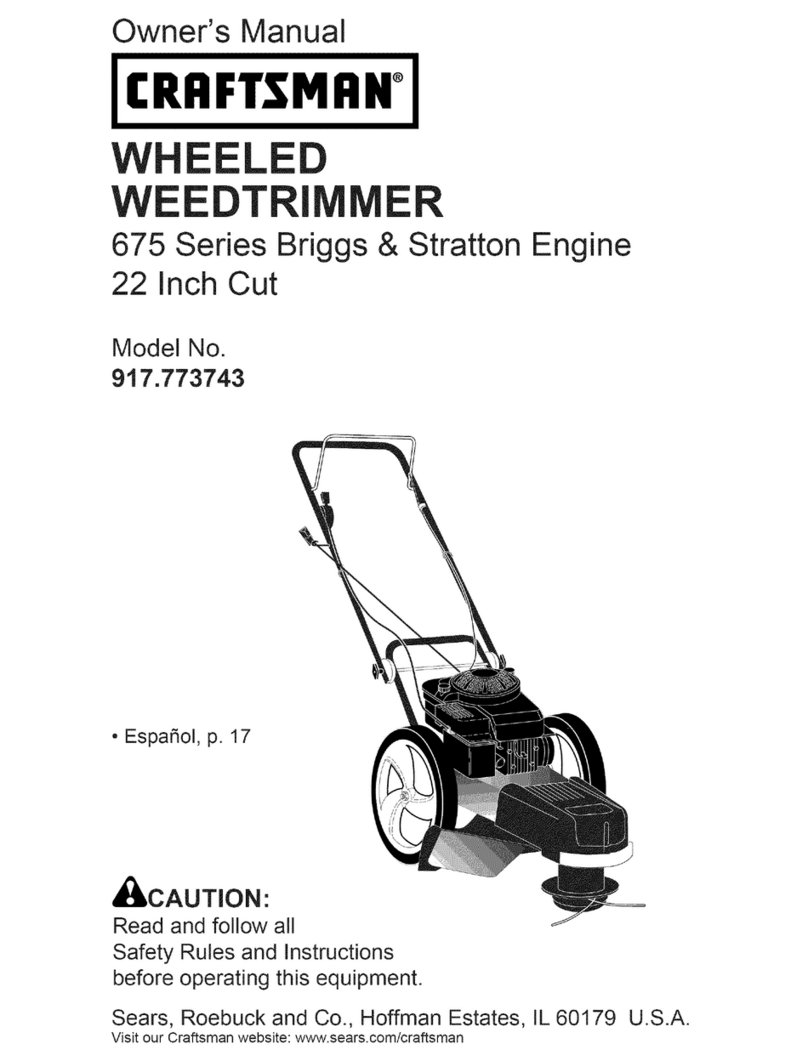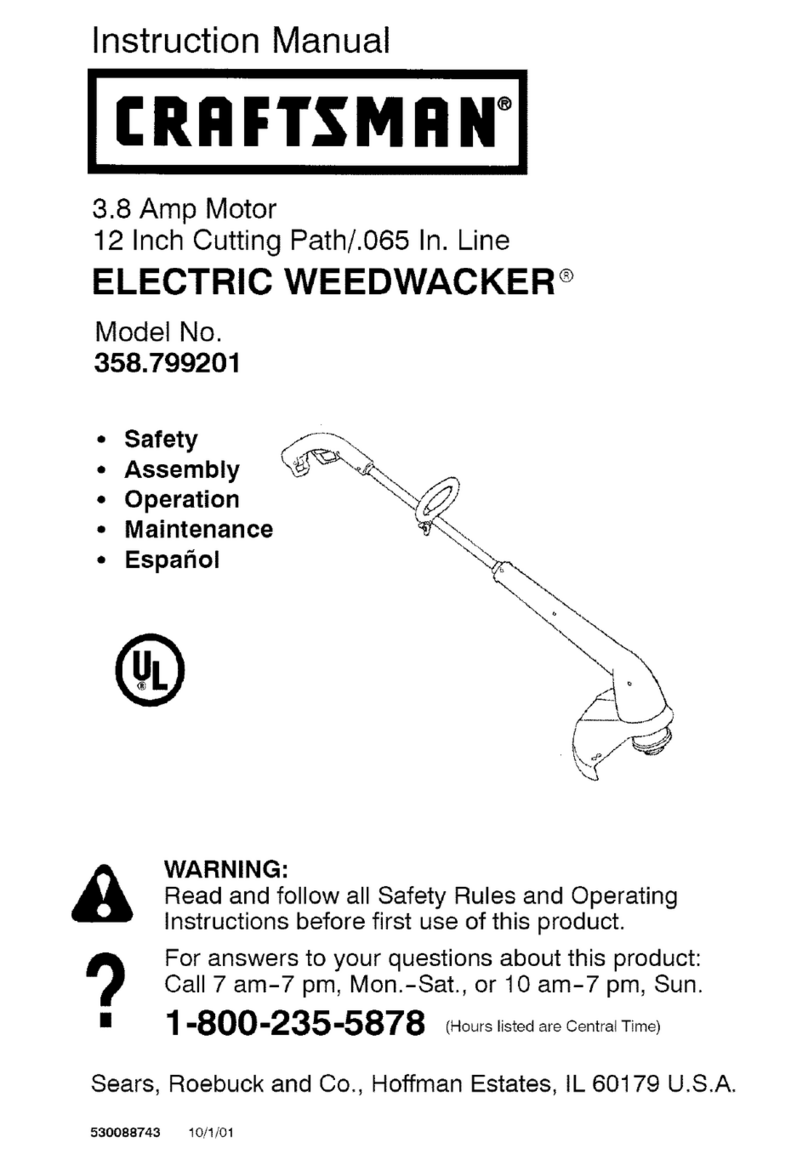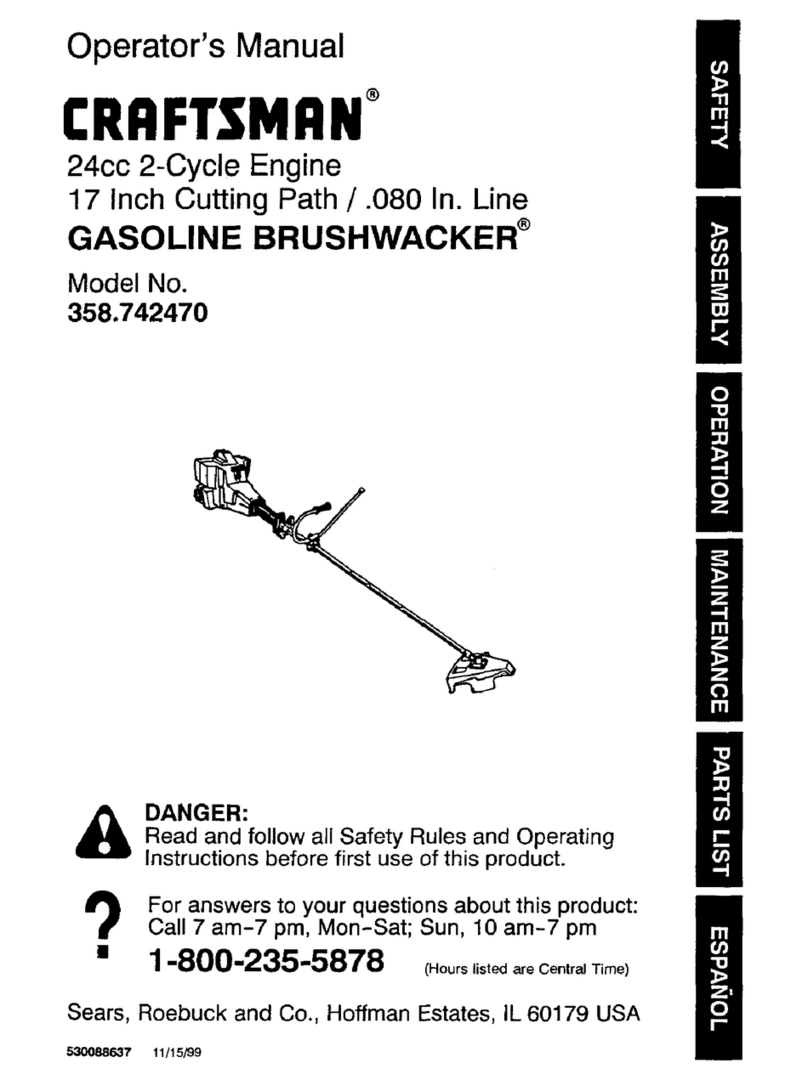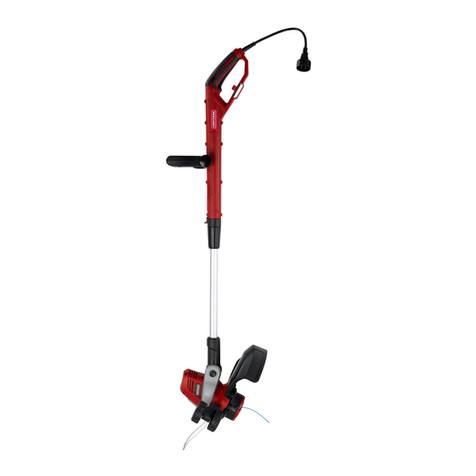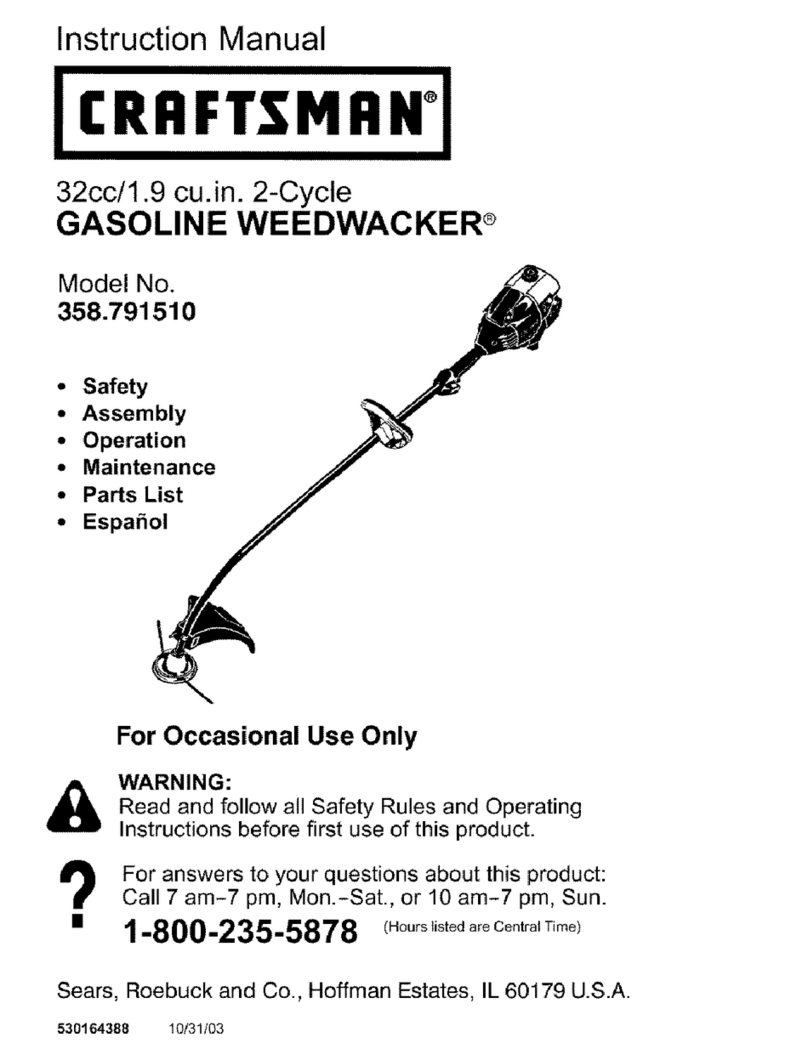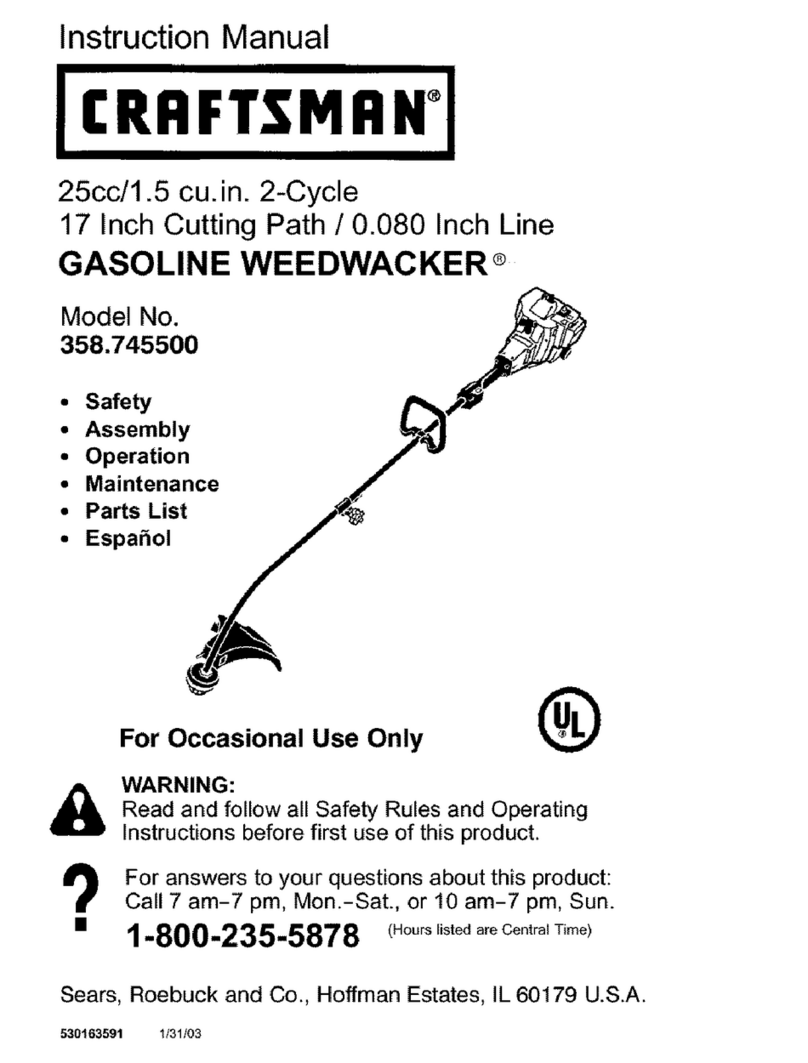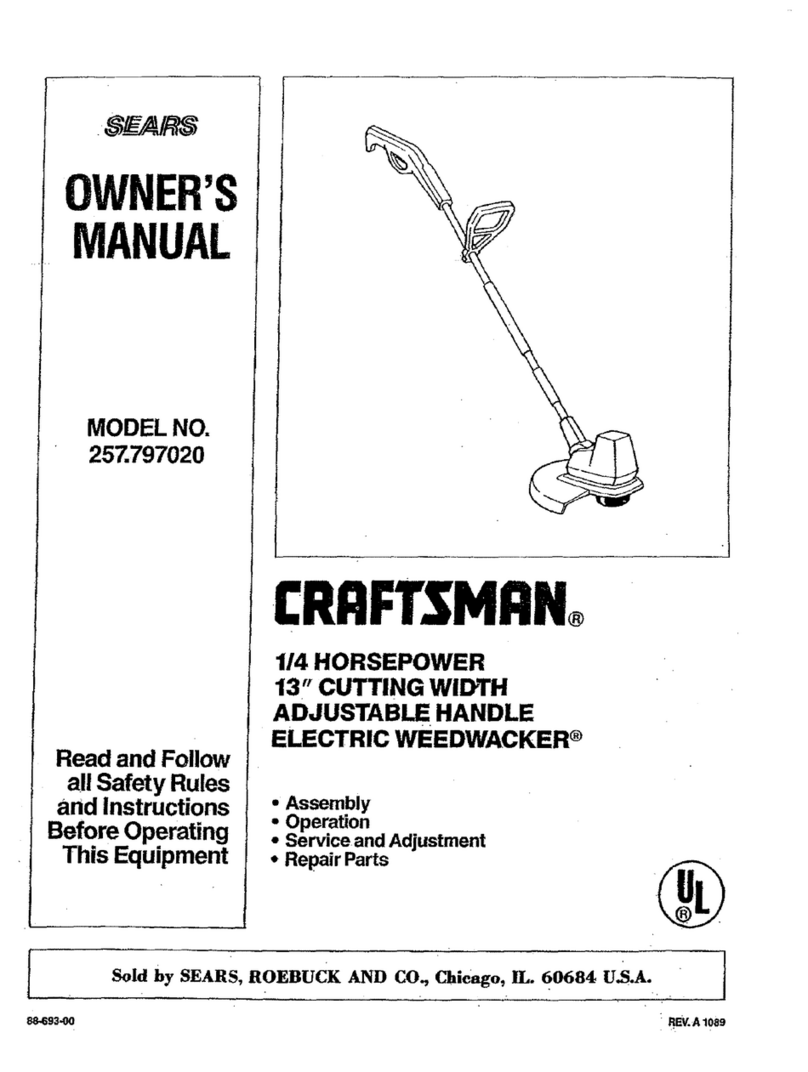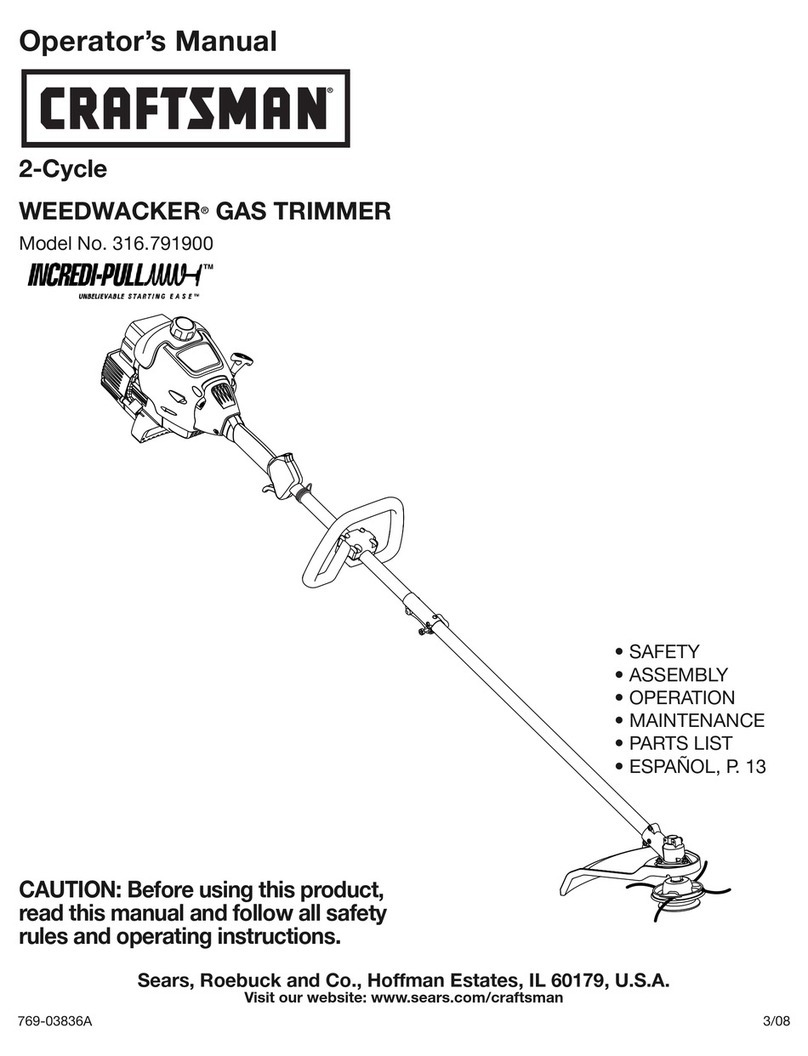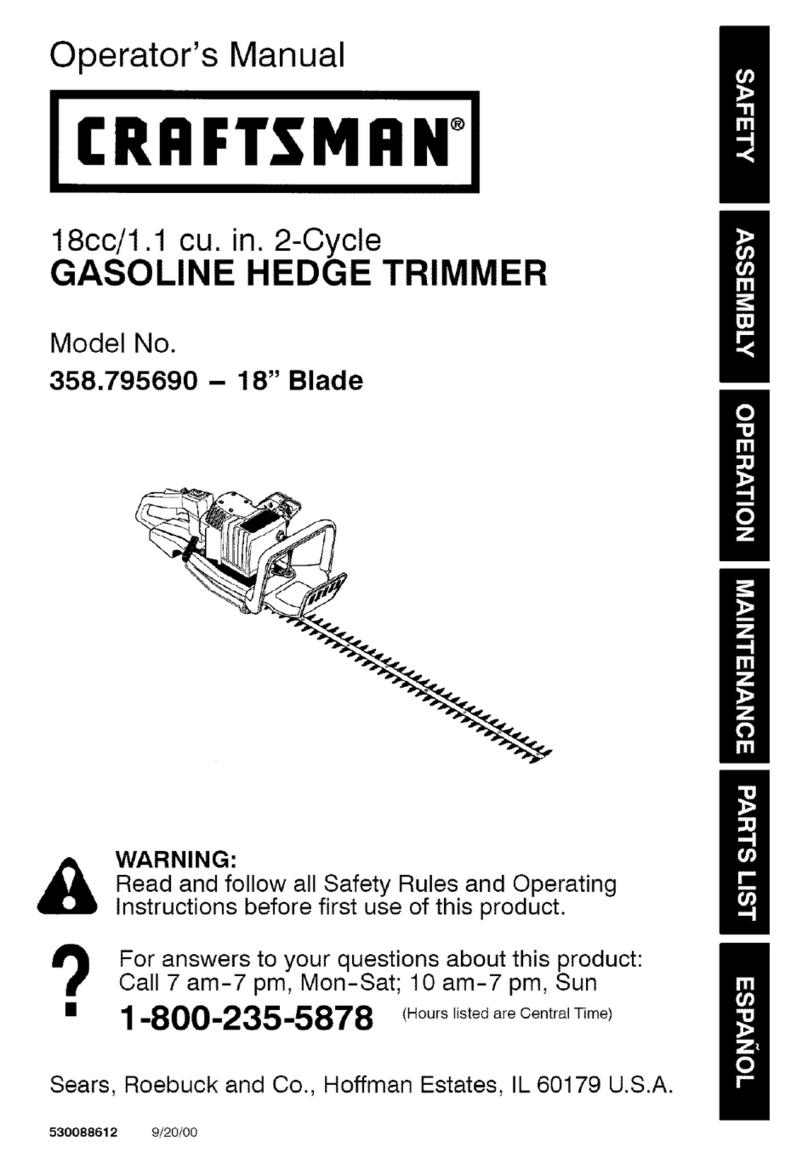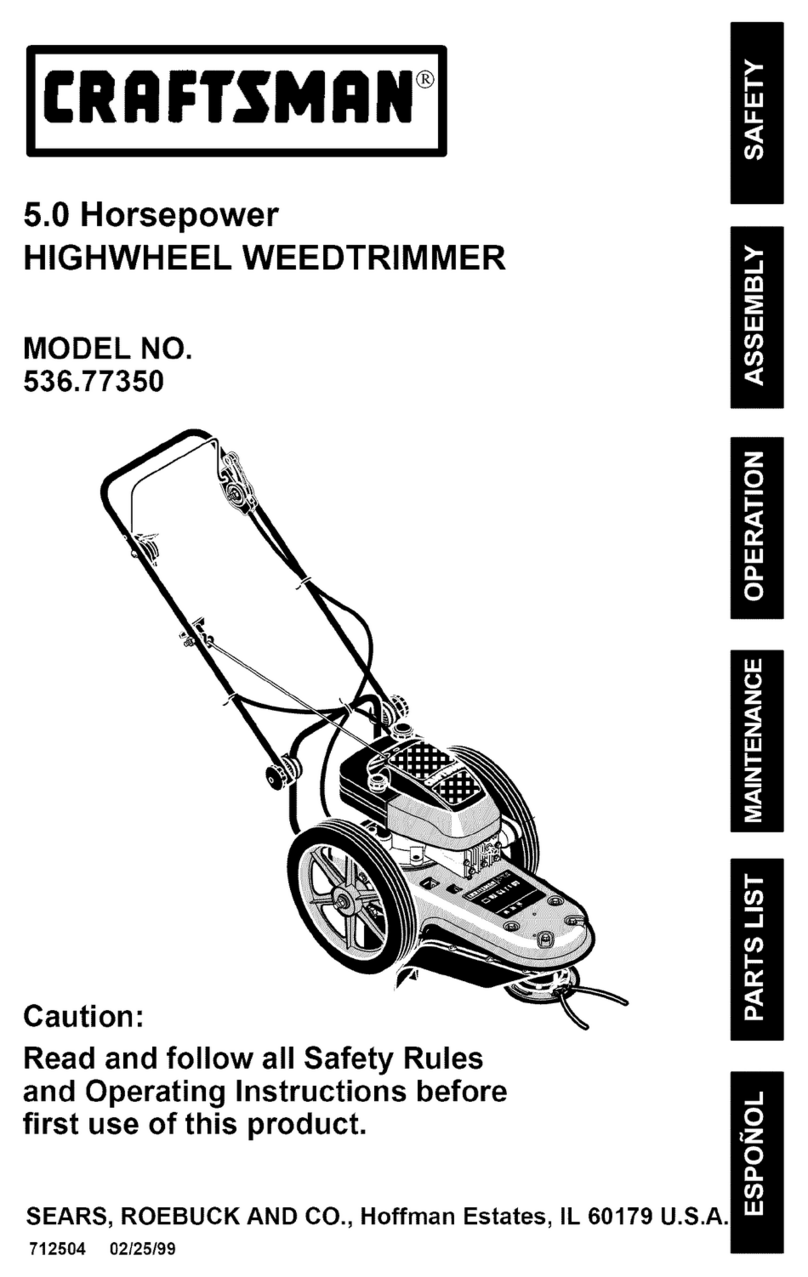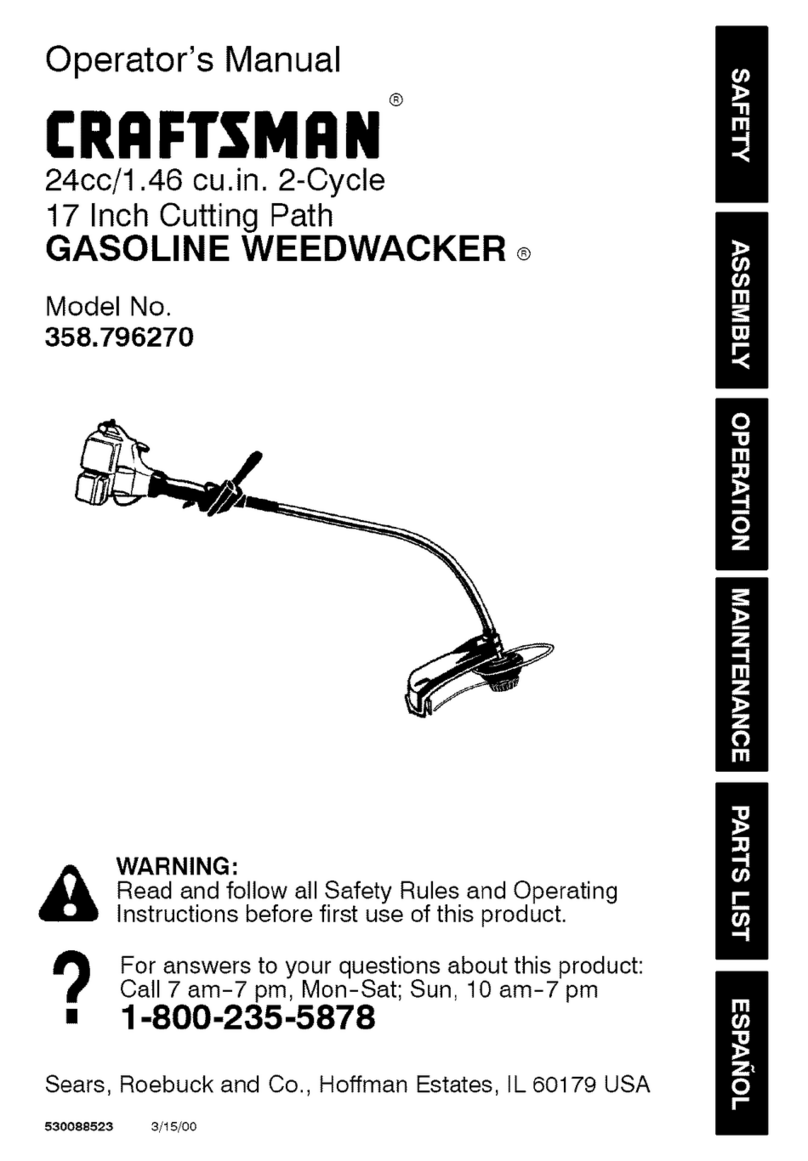WARNINGS AND SAFETY INSTRUCTIONS..,.(Continued)
Ak OPERATOR SAFETY
o
o
o
o
o
A
@
Always wear safety eye protection.
Always wear long pants, long sleeves, boots and
gloves: Wearing safety leg guards is recom-
mended. Do not go barefoot or wear sandals, jew-
elry, short pants, short sleeves, loose clothing, or
clothing with loosely hanging ties, straps, tassels,
etc.; they can be caught in moving parts.
Secure hair so it is above shoulder length.
Do not operate this unit when you are tired, ill, or
under the influence of alcohol, drugs, or medica-
tion.
Wear_hearingprotectionifyou use thisunitfor
more than 1-1/2hoursper day.
Never startorrun theengineinsideadosed room
orbuilding.Breathingexhaustfumes can kill.
Keep handlesfreeofoiland fuel.
UNIT/MAINTENANCE SAFETY
Look for and replace damaged or loose parts be-
fore each use. Look for and repair fuel leaks before
use. Keep the unit in good working condition.
Replac e trimmer head parts that are chipped,
cracked, broken, or damage in any other way be-
fore using the unit.
Use only .080" diameter SEARS Laser Line.
Never use wire, rope, string, etc.
Make sure the unit is assembled correctly as listed
in this manual.
Make carburetor adjustments with the lower end
supported to prevent the trimmer line from con-
tacting any object.
Keep others away when making carburetor ad-
justments.
Disconnect the spark plug before performing
maintenance except carburetor adjustments.
Use only genuine SEARS accessories and replace-
ment parts as recommended for this unit.
AFUEL SAFETY
•Mix and pour fuel outdoors.
•Keep away from sparks or flames.
•Use a container approved for fuel.
• Do not smoke or allow smoking near fuel or the
unit or while using the unit.
' Wipe up all fuel spills before starting engine.
•Move at least 10 feet (3 meters) away from fueling
site before starting engine.
• Stop engine and allowthe engine to cool before re-
moving fuelcap.
• Empty thefueltankbeforestoringtheunit.Use
up fuelleftinthe carburetorby startingtheen-
gineand lettingtheenginerun untilitstops.
•Storeunitand fuelinan _areawhere fuelvapors
cannotreachsparksor open flamesfrom water
heaters,electricmotorsorswitches,furnaces,etc.
Ak CUTTING SAFETY
• Inspect the area to be cut before each use. Remove
objects (rocks, broken glass, nails, wire, string,
etc.) which can be thrown or become entangled in
the trimmer head. x
• Keep others including children, animals, bystand-
ers and l_elpers outside the 60 foot (20 meter) Haz-
ard Zone. Stop the engine immediately if you are
approached. •....
•Always keep theengineon theright-handsideOf
yourbody.
- Hold theunitfn_nlywith bothhands.
•iKeep firm footingand balance.Do not over-
ireach.
•_Keep thetrimmer head belowwaistlevel.
•, Do notraisetheengineaboveyourwaist.
•'Keep allpartsofyour body away from trimmer
head and mufflerwhen engineisrunning.
•_Cut fromyour righttoyourleft.
• Use onlyforjobsexplainedinthismanual.
ATRANSPORTING AND STORAGE
• Stop the unit before transporting.
• Keep the muffler away from your body.
•Allow the engine to cool, and secure the unit be-
fore storing or transporting in a vehicle.
•Empty the fuel tank before storing or transport-
ing the unit. Use up fuel left in the carburetor by
starting the engine and letting the engine run un-
til it stops.
• Store unit and fuel in an area where fuel vapors
cannot reach sparks or open flames from water
heaters, electric motors or switches, furnaces, etc.
• Store unit so line limiter cannot accidentally
cause injury. The unit can be hung by the bracket
below the engine or by drive shaft housing.
•Store the unit out of the reach of children.
If situations occur which are not covered in this manual, use care and good judgment.
If you need assistance, contact your SEARS Service Center/Department or the
CUSTOMER ASSISTANCE HOTLINE, 1-800-235-5878.
H Exp_suret_vibrati_nsthr__ghpr___ngeduse_fgas__inep_weredhandt___sc_uldcauseb___dvesse__rnerve H
damage in the f'mgers, hands, and wrists of people prone to circulation disorders or abnormal swellings. Pro-
mlonged use in cold weather has been linked to blood vessel d.amage in otherwise healthy people. If symptoms M
occur such as numbness, pain, loss of strength, change in skin color or texture, or loss of feeling in the _gers,
H hands or wrists, discontinue the use of this tool and seek medical attention. An anti-vibration system does not _1
l_] guarantee the avoidance of these problems. Users who operate power tools on a continual and regular basis [_
__r doo_.se...lythe.._..._physiooooooo__.c_co_.diti0_noo_sndthe con&'tion of_ tool......................................_,_
4
